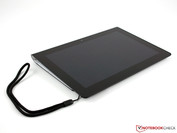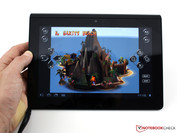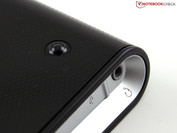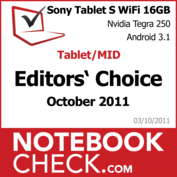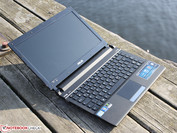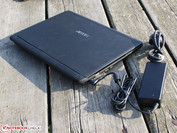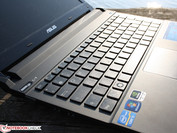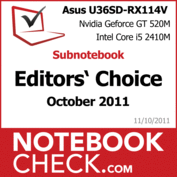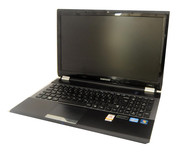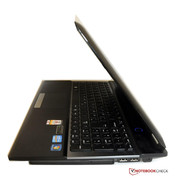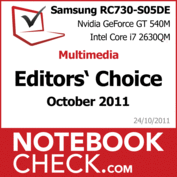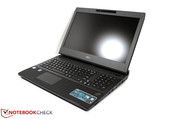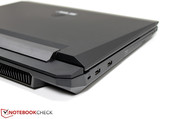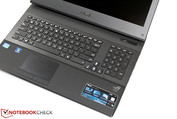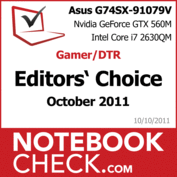Notebookcheck's Best of October 2011
October was dominated by nine multimedia laptops which all achieved a final rating between 78-81%. Unexciting standard units with no highlights? Not at all since we picked one of the cheapest available quad core notebooks on the market, among others. The large 17.3 inch Samsung RC730 is already available for starting at 649€. The 15.6 inch RC530 costs 700€.
The gaming notebook, Asus G74SX, finally had its turn among the stronger desktop replacements. It had to leave the glory to a superior rival (Alienware M18x) in the month of June. As for tablets, we were able to look at the Sony Tablet S1 serial device, which proved to be a well-conceived Android tablet. The Asus U36SD with an SSD was at the start among the subnotebooks. It could reap in a really good rating despite a bad screen.
The top devices of all categories from October are clearly summarized here for you.
Category: Tablet/MID
Contenders:
Lenovo ThinkPad Tablet 18382DG
Sony’s first tablet delights the eye with wide viewing angles and a high contrast (IPS screen). The 9.4 inch model, based on Nvidia’s Tegra 250 and Android 3.2, is state of the art. Its unique selling feature is its appearance because it looks like a folded over magazine. The chassis is light and pleasant to hold due to its curves and corners.
The Lenovo Ideapad K1 with Tegra 250 is a 10.1 inch device with Android 3.1. The screen provides very good contrasts, but a relatively low brightness of 276 cd/m2. The glare-type’s reflections often overlay the content on the screen. The battery life of five to 11 hours is impressive, but we weren’t happy with the workmanship in terms of irregular gaps (US serial device).
The ThinkPad tablet, with a matt 10.1 inch IPS screen, should have been introduced as a business tablet. IPS is at the start with good contrasts and wide viewing angles. However, the reflective "Corning Gorilla Glass" is reason for distortions all over. The runtime of 9:45 hours is very long, but the case's lack of robustness doesn’t do ThinkPads' reputation justice. The battery charge time is outrageously long – up to 24 hours. This was not a fault, but intention according to the manual.
We got hold of a Prestigio MultiPad from the low budget tablet field. The 8 inch model, based on an ARM Cortex A8 CPU and Android 2.3, works fast and can display flash contents and 1080p movies smoothly. The low base brightness and tight viewing angles speak against the miser. On the other hand, the 800x600 pixel’s contrast is feasible.
Tablet/MID of October 2011: Sony Tablet S
The S1 from Sony is the winner in regards to points. It offers the best display and the best workmanship in this quartet. The battery life of 5:30 hours is even lower than that of the Prestigio MultiPad (6-9:30 hours).
What we like
A screen with great colors and first rate viewing angles. A case that finally no longer looks like a rectangle.
What we'd like to see
DLNA and streaming are nice and good. But to play a little movie from the SD should be within the realm of possibilities, shouldn't it?
What surprises us
Why the S tablet gets so warm and so many other equally built systems don't.
The competition
Asus Eee Pad Slider; Acer Iconia Tab W500 Keydock; Samsung Galaxy Tab 10.1v; Motorola Xoom; Apple iPad 2; LG V900 Optimus Pad
Category Subnotebook
Contenders:
Acer’s first ultra-book, the S3, on the market is not overpriced. A moderate 799€ for the version with a 320 GB hard disk and a 20 GB flash memory is demanded for it. The new i5 2467M ensures good performance, but the loud, clacking hard disk lets buyers steal a side glance at the SSD version. The flat case’s stability is adequate, but it is difficult to type on the spongy keyboard. The rating of 76% is so low because the battery life of 3:33 hours lags behind all expectations.
The Aspire 3830TG with a battery life of six hours (WLAN test) is quite the opposite. The high-end version of the 13 inch model only has a contrast weak screen again. However, the hardware has been beefed up with a Core i7 2620M and an SSD memory in contrast to the first test device. Owing to a GeForce GT 540M, the temperature and system noise turn out to be moderate to low despite the gaming suitability. Gamers and performance aficionados won’t likely be happy about the evident CPU throttling during simultaneous GPU load. Other users won’t ever notice the "negative" Turbo feature.
Also equipped with an SSD, the Asus U36SD-RX114V was at the starting line. It doesn’t overdo it with gaming performance and only has a GeForce GT 520M. The slim 13.3 inch model that unfortunately has a glossy screen, is usually quiet, and manages a good battery life of 7:45 hours. The quality workmanship of the solid case is just as delightful as the feedback strong input devices, keyboard and touchpad.
The HP ProBook 5330m, as a 13.3 inch work subnotebook, is aimed at users who are looking for a high quality feel, very good input devices and a built in 3G module. The HD screen is naturally matt, but regrettably too dark and contrast weak. This is in line with the short battery life of 3:50 hours with a 41 Wh battery. The application performance can balance the score again thanks to the fast SSD. Consequently, it is still enough for a final rating of 82%.
Subnotebook of October 2011: Asus U36SD-RX114V (SSD)
The 1.7 kilogram heavy 13.3 inch device doesn’t have a hard time winning in October with its rating of 86%. With exception of the glare type, including poor contrasts and viewing angles, a well-designed subnotebook stood in the editorial office. It is suitable as a work notebook. Had Asus given the U36SD a matt screen with higher brightness and a 3G module, a perfect all-round subnotebook would have been created.
What we like
The stylish, solid case is an eye-catcher and escapes the laptop monotony with its angular shape. The fan often stays off and the power adapter can be forgotten with a battery life of almost eight hours.
What we'd like to see
A matt and bright screen would have made the U36SD to an extremely attractive outdoor companion.
What surprises us
Again and again surprising: An SSD makes standard hardware to a very fast device. CPU performance without significant throttling.
The competition with SSD:
Subnotebooks with GPU:
Samsung QX412-S04DE (14"); Acer TravelMate TimelineX 8473TG (14"); Aspire TimelineX 3830TG (13.3")
Subnotebooks with IGP:
HP ProBook 5330m; Dell Vostro V131; HP ProBook 6360b; Lenovo IBM ThinkPad Edge E420s; Toshiba Satellite R830-11C; Satellite R630-14X; Lenovo IdeaPad U260
Category Multimedia
Contenders:
HP ProBook 4730s-LH335EA/LH343EA
The lineup of our nine test models starts with the 15.6 inch Medion Akoya P6812 (MD98760). It is equipped with gaming suitable GeForce GT 555M and, nevertheless, only costs 549€. A little heater? No, buyers neither have to wear ear protection nor welding gloves. Temperatures and system noise remain moderate. The LG P530 plays on a completely different level. It doesn’t want to be a gaming laptop with its entry level graphics, GeForce GT 520M and Core i5 2520M, but sooner an all-rounder. The elegant, but partly unstable case unfortunately only includes a clattery, yielding keyboard. The HD screen with a very poor contrast and narrow viewing angles corresponds to the above mentioned Akoya P6812 and is thus very poor.
The 14 inch Dell XPS 14z comes along with a very similar configuration as the LG P530. The GeForce GT 520M is again a no-go for gaming fans. In return, Dell hasn’t made cutbacks in stability or quality of the aluminum case. The keyboard has an LED light and bids, alike the touchpad, an acceptable feedback. The battery life of 3:50 hours is just as scanty as the display with its poor image contrast and the glossy surface.
Samsung seems to have specialized in the field of performance-value configurations. The RC530-S01DE (15.6 inch) with a GeForce GT 540M and Core i7 2630QM is available for starting at 688€. The Packard Bell EasyNote TS11 or the Acer Aspire 5750G can also do that, but these rivals don’t have a matt screen, such a solid case or keys with a crisp pressure point. The battery life of six hours (WLAN test) is very good despite the quad core.
Dell’s Inspiron 14z is a basic entry level notebook in terms of technologies and, unfortunately, also due to partly unsatisfactory workmanship. The unusual design can’t hide the stiff touchpad and the irregular gaps. The glare-type HD screen is a member of the contrast and viewing angle weak category as has been used a multitude of times. Consequently, outdoor use doesn't come in question for the too dark screen, although the battery life of seven to ten hours could advocate it.
Sony also has basic multimedia models in its range, such as the Vaio VPC-EH1Z1E/B. A weak graphics card has been installed into the 15.5 inch device with the GeForce 410M. It fails in the latest games, as well in medium details. We can also speak of failure in view of mobility because of its very poor 2:25 hours (WLAN test) and the contrast weak, too dark screen. Buyers who are looking for pretty looks, low system noise and good input devices are well served with the Vaio, though.
AMD also regains market shares with the A series, A8-3500M, among others. It is found in Acer’s Aspire 5560G. For 550€, the dual GPU Radeon HD 6740G2 provides a useable gaming performance that however lags behind the Geforce GT 540M. In return, the temperatures and system noise remain low. The battery life of 2:38 hours is too little even for this price range.
When hunting for the best ratio of performance and price, the Samsung RC730-S05DE with a GeForce GT 540M and Core i7 2630QM is right among the top devices. The 17.3 inch device with a WXGA++ resolution (1600x900) is available for 649€. The rigid case, the battery life of 4:18 hours and the low system noise are on the RC730’s pro side. The buyer however has to be prepared to make compromises in view of the contrast weak screen and the difficult to use mouse replacement.
The HP ProBook 4730s is a business device, but slipped into the multimedia category due to its Radeon HD 6490M graphics. The 17.3 inch model can only reproduce pale colors on its 1600x900 pixels and the viewing angles are poor. The high application performance with the Core i5 is pretty good, but is paid for with high temperatures and permanently audible system noise. The battery life of 3:40 hours is all right for the 17 inch size, the touchpad’s poor gliding traits doesn’t meet up to expectations, though.
Multimedia Notebook of October 2011: Samsung RC530
The decision wasn’t easy because the Akoya P6812 and the Samsung RC530 have an equal rating of 81%. The Aldi laptop definitely has the better gaming performance with the Geforce GT 555M, that isn’t even slowed down by the installed Core i3. The RC530 costs a bit more, but has the higher quality case, the better keyboard and Silent Mode. Both screens have a poor contrast, but at least the Samsung’s is anti-glare.
What we like
The Samsung RC530's keyboard and robustness could especially convince us. The combination of a bright and anti-glare screen upgrades the laptop even more.
What we'd like to see
We have a bad feeling about the meager connections and communication means in a multimedia device. We miss modules such as USB 3.0, eSATA or Bluetooth in this model.
What surprises us
Even notebooks where CPU throttling isn't necessarily expected struggle with this problem again and again.
The competition
Alienware M14x notebook, Samsung RF511 notebook, Schenker XMG A501 notebook (Clevo W150HRM), Dell XPS 15z notebook, Fujitsu Lifebook NH751 notebook, Gigabyte P2532N notebook, Packard Bell EasyNote NX69-HR-127GE notebook, Samsung QX412-S01DE notebook, Sony Vaio VPC-F22S1E/B (FHD) notebook, Acer Aspire 4830TG notebook
Category Gaming / DTR
Contenders:
Toshiba Satellite P775-100 3D-Vision
The Asus N75SF continues where the Medion Akoya P6812 (multimedia) left off. It has the same Geforce GT 555M graphics card, but owing to an external subwoofer, it has a much better sound for games and music. The Full HD screen with 1920x1080 pixels is bright, has very high contrasts and the viewing angles are apt for a TV night for four. There wasn't any price pressure in terms of processor. The 17.3 inch model is well-equipped for the future with a Core i7 2630QM. Despite the high performance, the emissions are low (waste heat and noise). The "low" rating of 83% is the result of the second rate keyboard and the few interfaces.
The Satellite P775-100 from Toshiba comes with Nvidia's 3D glasses. Thus, the third dimension can be enjoyed in both games and 3D movies. Unfortunately, the manufacturer has dressed its premium model (almost 1500€) in the same cheap plastic coat as the equally built P770-10P. The low final rating of 79% is caused by the annoying system noise, high temperatures and especially the pale Full HD screen. The good sound, the enormous memory capacity due to 2 x 750GB (no RAID) and the key light are remarkable advantages. But the graphics performance and the input devices' quality is too poor for a DTR.
The Lenovo G770 belongs to the manufacturer's basic line. However, it can't be said to have basic performance considering that a Core i7 2620M (dual core) and a Radeon HD 6650M are united in the 17.3 inch laptop. The screen has a resolution of 1600x900 pixels, but it only bids faint contrasts, a small sRGB color spectrum and very narrow viewing angles. Both the low temperature and the even more quiet system noise are bestowed with a "Very Good". We hear a maximum of 38 dB (A) even when playing a game. The gaming performance can't exploit the native resolution. However, it is good enough for the latest games in 1366x768 pixels. The wobbly hinge was noticed adversely. It is too small for this size.
The G74SX-91070V is Asus' gaming standard. Thus, no cutbacks have been made on the surface quality and stability. The bulky and resistant case stays quite cool even under load and is accompanied by a moderate noise development. The sound system, supported by a subwoofer and the Blu-Ray drive are in line with the concept, just as much as the GeForce GTX 560M and the Core i7 2630QM. This partly allows current games to be played even in the native Full HD resolution with high contrasts.
Medion sends in a gamer with the same CPU-GPU components as the aforementioned Asus G74SX. The gaming performance is thus on the same high level. The Erazer X6817's application performance is higher thanks to Intel's fast SSD, though. The HD resolution with only 1366x768 pixels is questionable for gamers in view of the GPU performance. The very low contrast and the modest viewing angle stability finish off the picture negatively and prevent the 15.6 inch laptop from achieving a better rating. But it wouldn't have received a "Very Good" anyway because the input devices only bid a weak feedback and the system noise is far too high. In terms of price, the configuration can't be beaten with 1099€. A G74SX costs 1800€ with the same CPU/GPU.
Gaming Notebook of October 2011: Asus G74SX
After the Asus G74SX (US model) didn't quite make the winner's podium and had to leave it to the Alienware M18x in June, the 17.3 inch laptop can now rest on its laurels. The now available serial device doesn't make a single mistake with the screen and has an advantage over other devices in this DTR round. Even the strong color screen in the N75SF is darker than the G74SX's. The highlight: The G74SX's screen is matt.
What we like
Above all else the exceptionally good display.
What we'd like to see
A graphics switching solution and more interfaces.
What surprises us
How quiet the notebook stays under load.
The competition
17 inch gaming notebooks like the Alienware M17x, the DevilTech Fragbook, the MSI GT780R, the Schenker XMG P701 PRO or the Toshiba Qosmio X770.


 Deutsch
Deutsch English
English Español
Español Français
Français Italiano
Italiano Nederlands
Nederlands Polski
Polski Português
Português Русский
Русский Türkçe
Türkçe Svenska
Svenska Chinese
Chinese Magyar
Magyar